ECU FIAT 500 ABARTH 2014 2.G User Guide
[x] Cancel search | Manufacturer: FIAT, Model Year: 2014, Model line: 500 ABARTH, Model: FIAT 500 ABARTH 2014 2.GPages: 88, PDF Size: 5.56 MB
Page 3 of 88
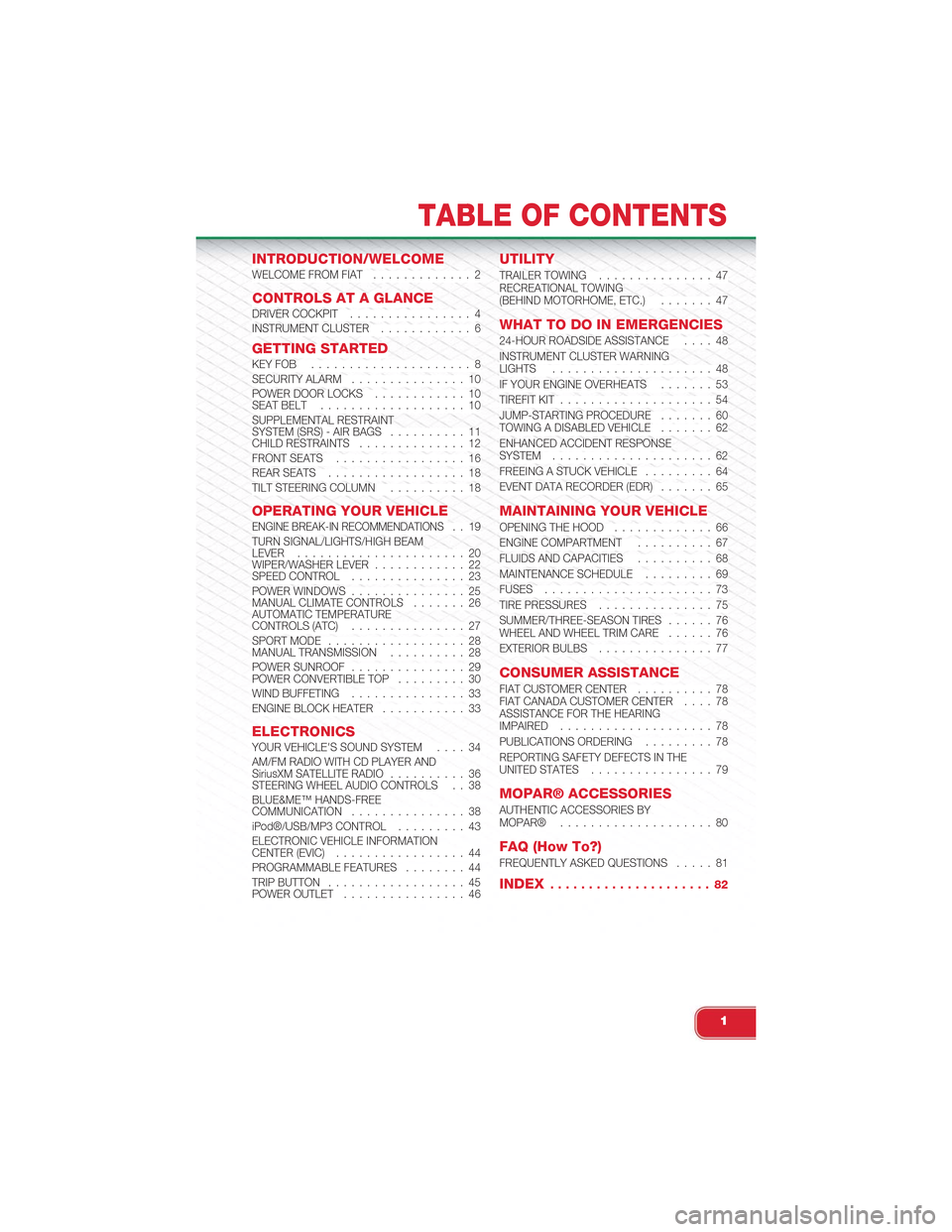
INTRODUCTION/WELCOMEWELCOME FROM FIAT............. 2
CONTROLS AT A GLANCEDRIVER COCKPIT................ 4INSTRUMENT CLUSTER............ 6
GETTING STARTEDKEY FOB . . . . . . . . . . . . . . . . . . . . . 8SECURITY ALARM. . . . . . . . . . . . . . . 10POWER DOOR LOCKS. . . . . . . . . . . . 10SEAT BELT. . . . . . . . . . . . . . . . . . . 10SUPPLEMENTAL RESTRAINTSYSTEM (SRS) - AIR BAGS. . . . . . . . . . 11CHILD RESTRAINTS. . . . . . . . . . . . . . 12FRONT SEATS. . . . . . . . . . . . . . . . . 16REAR SEATS. . . . . . . . . . . . . . . . . . 18TILT STEERING COLUMN. . . . . . . . . . 18
OPERATING YOUR VEHICLEENGINE BREAK-IN RECOMMENDATIONS. . 19TURN SIGNAL/LIGHTS/HIGH BEAMLEVER. . . . . . . . . . . . . . . . . . . . . . 20WIPER/WASHER LEVER. . . . . . . . . . . . 22SPEED CONTROL. . . . . . . . . . . . . . . 23POWER WINDOWS. . . . . . . . . . . . . . . 25MANUAL CLIMATE CONTROLS. . . . . . . 26AUTOMATIC TEMPERATURECONTROLS (ATC). . . . . . . . . . . . . . . 27SPORT MODE. . . . . . . . . . . . . . . . . . 28MANUAL TRANSMISSION. . . . . . . . . . 28POWER SUNROOF. . . . . . . . . . . . . . . 29POWER CONVERTIBLE TOP. . . . . . . . . 30WIND BUFFETING. . . . . . . . . . . . . . . 33ENGINE BLOCK HEATER. . . . . . . . . . . 33
ELECTRONICSYOUR VEHICLE'S SOUND SYSTEM. . . . 34AM/FM RADIO WITH CD PLAYER ANDSiriusXM SATELLITE RADIO. . . . . . . . . . 36STEERING WHEEL AUDIO CONTROLS . . 38BLUE&ME™ HANDS-FREECOMMUNICATION. . . . . . . . . . . . . . . 38iPod®/USB/MP3 CONTROL. . . . . . . . . 43ELECTRONIC VEHICLE INFORMATIONCENTER (EVIC). . . . . . . . . . . . . . . . . 44PROGRAMMABLE FEATURES. . . . . . . . 44TRIP BUTTON. . . . . . . . . . . . . . . . . . 45POWER OUTLET. . . . . . . . . . . . . . . . 46
UTILITY
TRAILER TOWING. . . . . . . . . . . . . . . 47RECREATIONAL TOWING(BEHIND MOTORHOME, ETC.). . . . . . . 47
WHAT TO DO IN EMERGENCIES
24-HOUR ROADSIDE ASSISTANCE. . . . 48INSTRUMENT CLUSTER WARNINGLIGHTS. . . . . . . . . . . . . . . . . . . . . 48IF YOUR ENGINE OVERHEATS. . . . . . . 53TIREFIT KIT. . . . . . . . . . . . . . . . . . . . 54JUMP-STARTING PROCEDURE. . . . . . . 60TOWING A DISABLED VEHICLE. . . . . . . 62ENHANCED ACCIDENT RESPONSESYSTEM. . . . . . . . . . . . . . . . . . . . . 62FREEING A STUCK VEHICLE. . . . . . . . . 64EVENT DATA RECORDER (EDR). . . . . . . 65
MAINTAINING YOUR VEHICLE
OPENING THE HOOD. . . . . . . . . . . . . 66ENGINE COMPARTMENT. . . . . . . . . . 67FLUIDS AND CAPACITIES. . . . . . . . . . 68MAINTENANCE SCHEDULE. . . . . . . . . 69FUSES. . . . . . . . . . . . . . . . . . . . . . 73TIRE PRESSURES. . . . . . . . . . . . . . . 75SUMMER/THREE-SEASON TIRES. . . . . . 76WHEEL AND WHEEL TRIM CARE. . . . . . 76EXTERIOR BULBS. . . . . . . . . . . . . . . 77
CONSUMER ASSISTANCE
FIAT CUSTOMER CENTER. . . . . . . . . . 78FIAT CANADA CUSTOMER CENTER. . . . 78ASSISTANCE FOR THE HEARINGIMPAIRED. . . . . . . . . . . . . . . . . . . . 78PUBLICATIONS ORDERING. . . . . . . . . 78REPORTING SAFETY DEFECTS IN THEUNITED STATES. . . . . . . . . . . . . . . . 79
MOPAR® ACCESSORIES
AUTHENTIC ACCESSORIES BYMOPAR®. . . . . . . . . . . . . . . . . . . . 80
FAQ (How To?)
FREQUENTLY ASKED QUESTIONS. . . . . 81
INDEX. . . . . . . . . . . . . . . . . . . . . 82
TABLE OF CONTENTS
1
Page 12 of 88
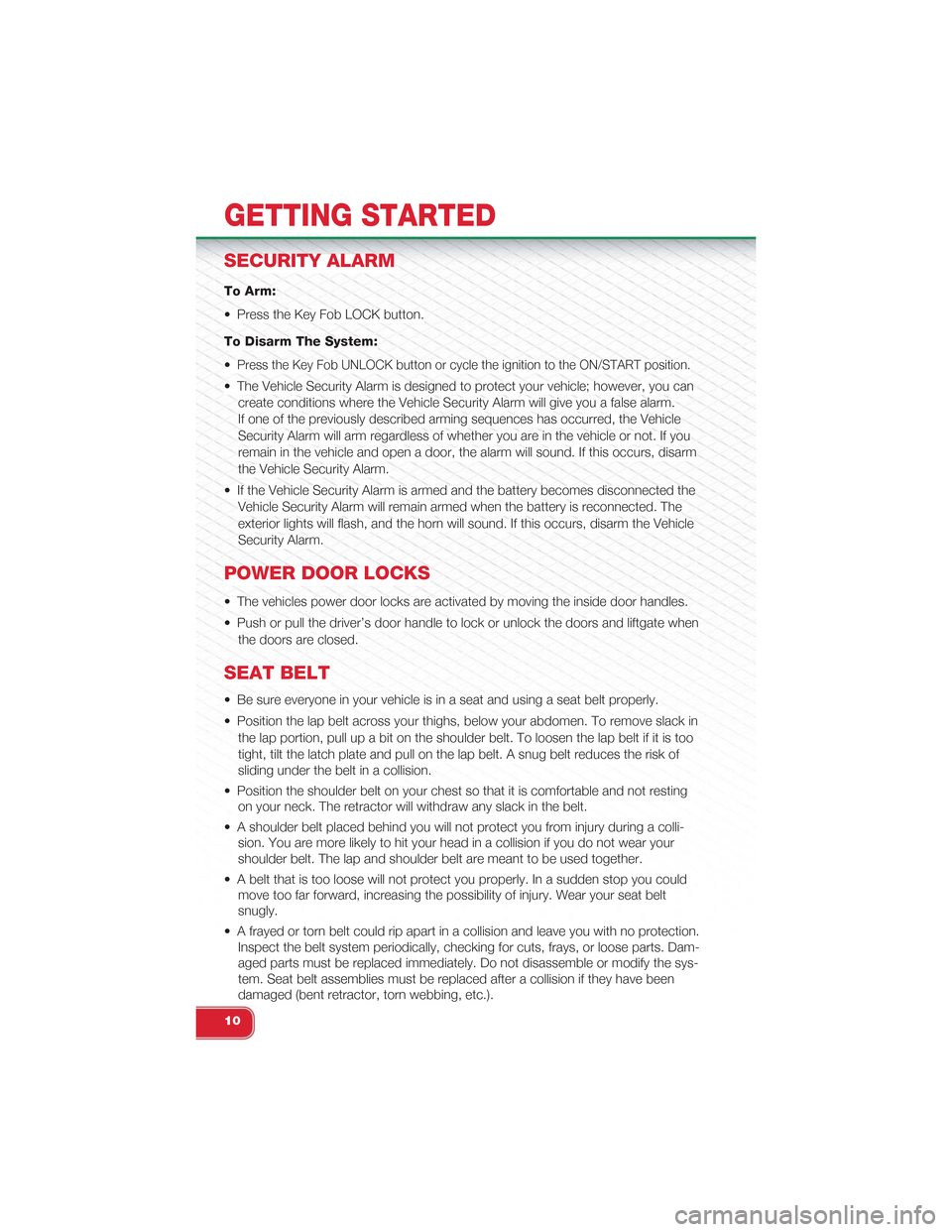
SECURITY ALARM
To Arm:
• Press the Key Fob LOCK button.
To Disarm The System:
•Press the Key Fob UNLOCK button or cycle the ignition to the ON/START position.
• The Vehicle Security Alarm is designed to protect your vehicle; however, you can
create conditions where the Vehicle Security Alarm will give you a false alarm.
If one of the previously described arming sequences has occurred, the Vehicle
Security Alarm will arm regardless of whether you are in the vehicle or not. If you
remain in the vehicle and open a door, the alarm will sound. If this occurs, disarm
the Vehicle Security Alarm.
• If the Vehicle Security Alarm is armed and the battery becomes disconnected the
Vehicle Security Alarm will remain armed when the battery is reconnected. The
exterior lights will flash, and the horn will sound. If this occurs, disarm the Vehicle
Security Alarm.
POWER DOOR LOCKS
• The vehicles power door locks are activated by moving the inside door handles.
• Push or pull the driver’s door handle to lock or unlock the doors and liftgate when
the doors are closed.
SEAT BELT
• Be sure everyone in your vehicle is in a seat and using a seat belt properly.
• Position the lap belt across your thighs, below your abdomen. To remove slack in
the lap portion, pull up a bit on the shoulder belt. To loosen the lap belt if it is too
tight, tilt the latch plate and pull on the lap belt. A snug belt reduces the risk of
sliding under the belt in a collision.
• Position the shoulder belt on your chest so that it is comfortable and not resting
on your neck. The retractor will withdraw any slack in the belt.
• A shoulder belt placed behind you will not protect you from injury during a colli-
sion. You are more likely to hit your head in a collision if you do not wear your
shoulder belt. The lap and shoulder belt are meant to be used together.
• A belt that is too loose will not protect you properly. In a sudden stop you could
move too far forward, increasing the possibility of injury. Wear your seat belt
snugly.
• A frayed or torn belt could rip apart in a collision and leave you with no protection.
Inspect the belt system periodically, checking for cuts, frays, or loose parts. Dam-
aged parts must be replaced immediately. Do not disassemble or modify the sys-
tem. Seat belt assemblies must be replaced after a collision if they have been
damaged (bent retractor, torn webbing, etc.).
GETTING STARTED
10
Page 14 of 88
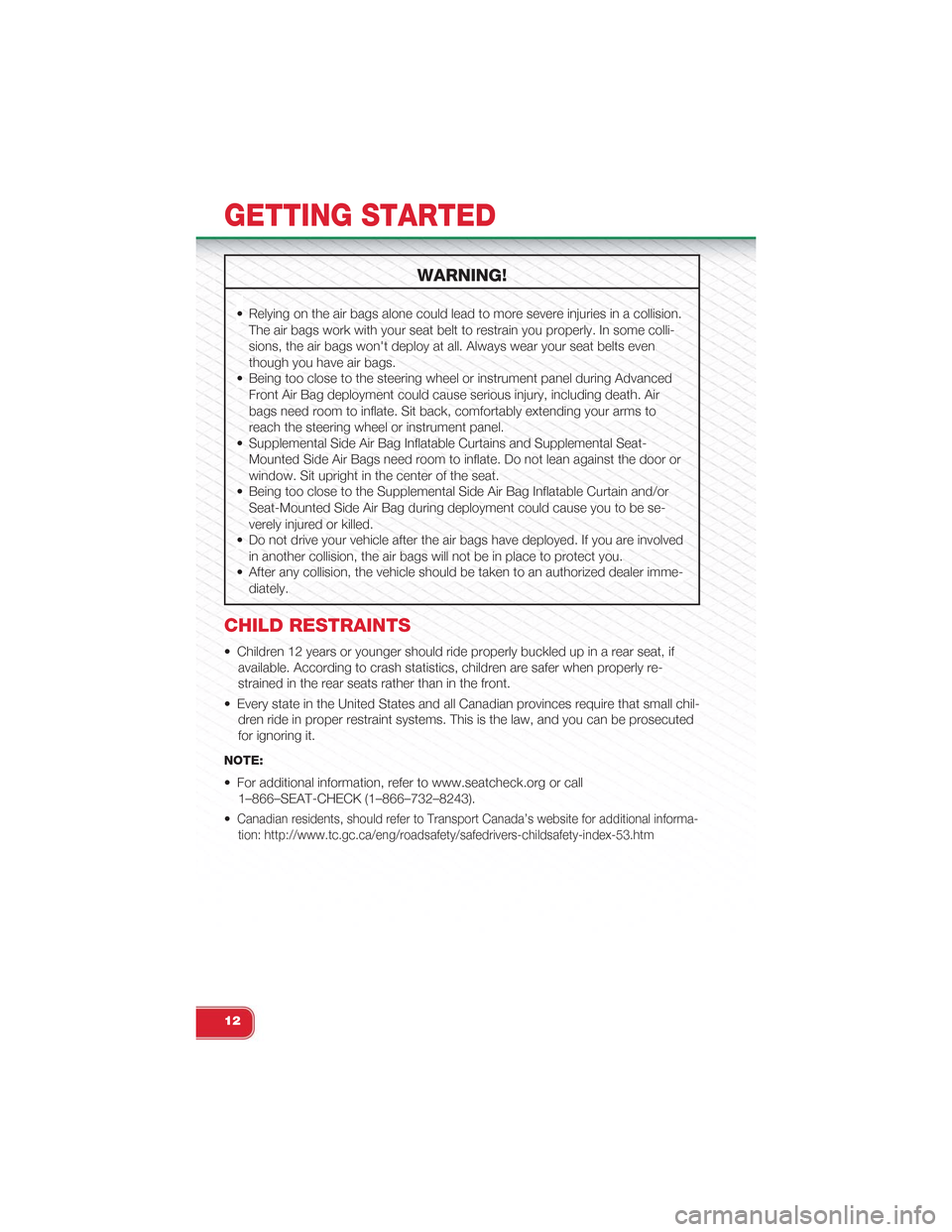
WARNING!
• Relying on the air bags alone could lead to more severe injuries in a collision.
The air bags work with your seat belt to restrain you properly. In some colli-
sions, the air bags won't deploy at all. Always wear your seat belts even
though you have air bags.
• Being too close to the steering wheel or instrument panel during Advanced
Front Air Bag deployment could cause serious injury, including death. Air
bags need room to inflate. Sit back, comfortably extending your arms to
reach the steering wheel or instrument panel.
• Supplemental Side Air Bag Inflatable Curtains and Supplemental Seat-
Mounted Side Air Bags need room to inflate. Do not lean against the door or
window. Sit upright in the center of the seat.
• Being too close to the Supplemental Side Air Bag Inflatable Curtain and/or
Seat-Mounted Side Air Bag during deployment could cause you to be se-
verely injured or killed.
• Do not drive your vehicle after the air bags have deployed. If you are involved
in another collision, the air bags will not be in place to protect you.
• After any collision, the vehicle should be taken to an authorized dealer imme-
diately.
CHILD RESTRAINTS
• Children 12 years or younger should ride properly buckled up in a rear seat, if
available. According to crash statistics, children are safer when properly re-
strained in the rear seats rather than in the front.
• Every state in the United States and all Canadian provinces require that small chil-
dren ride in proper restraint systems. This is the law, and you can be prosecuted
for ignoring it.
NOTE:
• For additional information, refer to www.seatcheck.org or call
1–866–SEAT-CHECK (1–866–732–8243).
•Canadian residents, should refer to Transport Canada’s website for additional informa-
tion: http://www.tc.gc.ca/eng/roadsafety/safedrivers-childsafety-index-53.htm
GETTING STARTED
12
Page 17 of 88
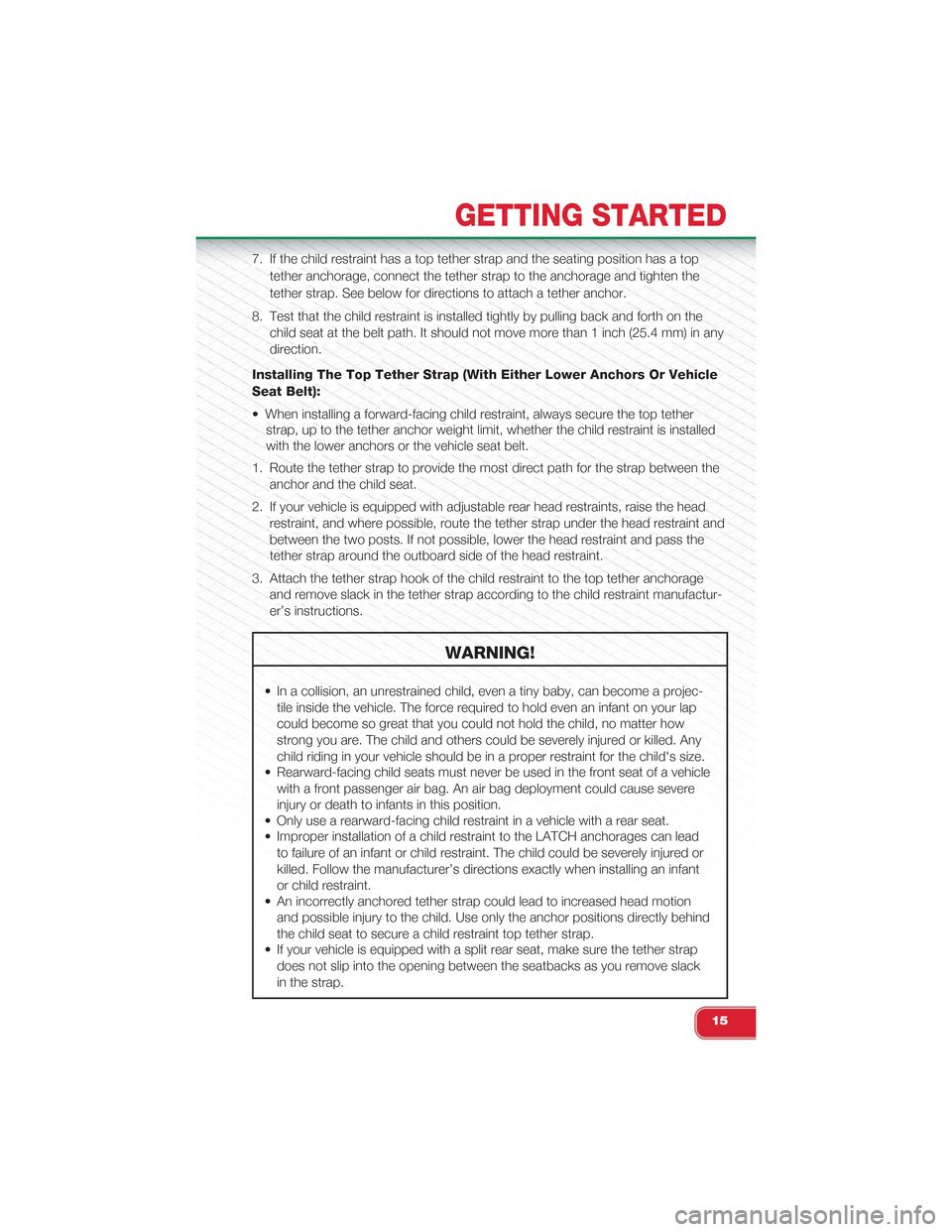
7. If the child restraint has a top tether strap and the seating position has a top
tether anchorage, connect the tether strap to the anchorage and tighten the
tether strap. See below for directions to attach a tether anchor.
8. Test that the child restraint is installed tightly by pulling back and forth on the
child seat at the belt path. It should not move more than 1 inch (25.4 mm) in any
direction.
Installing The Top Tether Strap (With Either Lower Anchors Or Vehicle
Seat Belt):
• When installing a forward-facing child restraint, always secure the top tether
strap, up to the tether anchor weight limit, whether the child restraint is installed
with the lower anchors or the vehicle seat belt.
1. Route the tether strap to provide the most direct path for the strap between the
anchor and the child seat.
2. If your vehicle is equipped with adjustable rear head restraints, raise the head
restraint, and where possible, route the tether strap under the head restraint and
between the two posts. If not possible, lower the head restraint and pass the
tether strap around the outboard side of the head restraint.
3. Attach the tether strap hook of the child restraint to the top tether anchorage
and remove slack in the tether strap according to the child restraint manufactur-
er’s instructions.
WARNING!
• In a collision, an unrestrained child, even a tiny baby, can become a projec-
tile inside the vehicle. The force required to hold even an infant on your lap
could become so great that you could not hold the child, no matter how
strong you are. The child and others could be severely injured or killed. Any
child riding in your vehicle should be in a proper restraint for the child's size.
• Rearward-facing child seats must never be used in the front seat of a vehicle
with a front passenger air bag. An air bag deployment could cause severe
injury or death to infants in this position.
• Only use a rearward-facing child restraint in a vehicle with a rear seat.
• Improper installation of a child restraint to the LATCH anchorages can lead
to failure of an infant or child restraint. The child could be severely injured or
killed. Follow the manufacturer’s directions exactly when installing an infant
or child restraint.
• An incorrectly anchored tether strap could lead to increased head motion
and possible injury to the child. Use only the anchor positions directly behind
the child seat to secure a child restraint top tether strap.
• If your vehicle is equipped with a split rear seat, make sure the tether strap
does not slip into the opening between the seatbacks as you remove slack
in the strap.
GETTING STARTED
15
Page 31 of 88
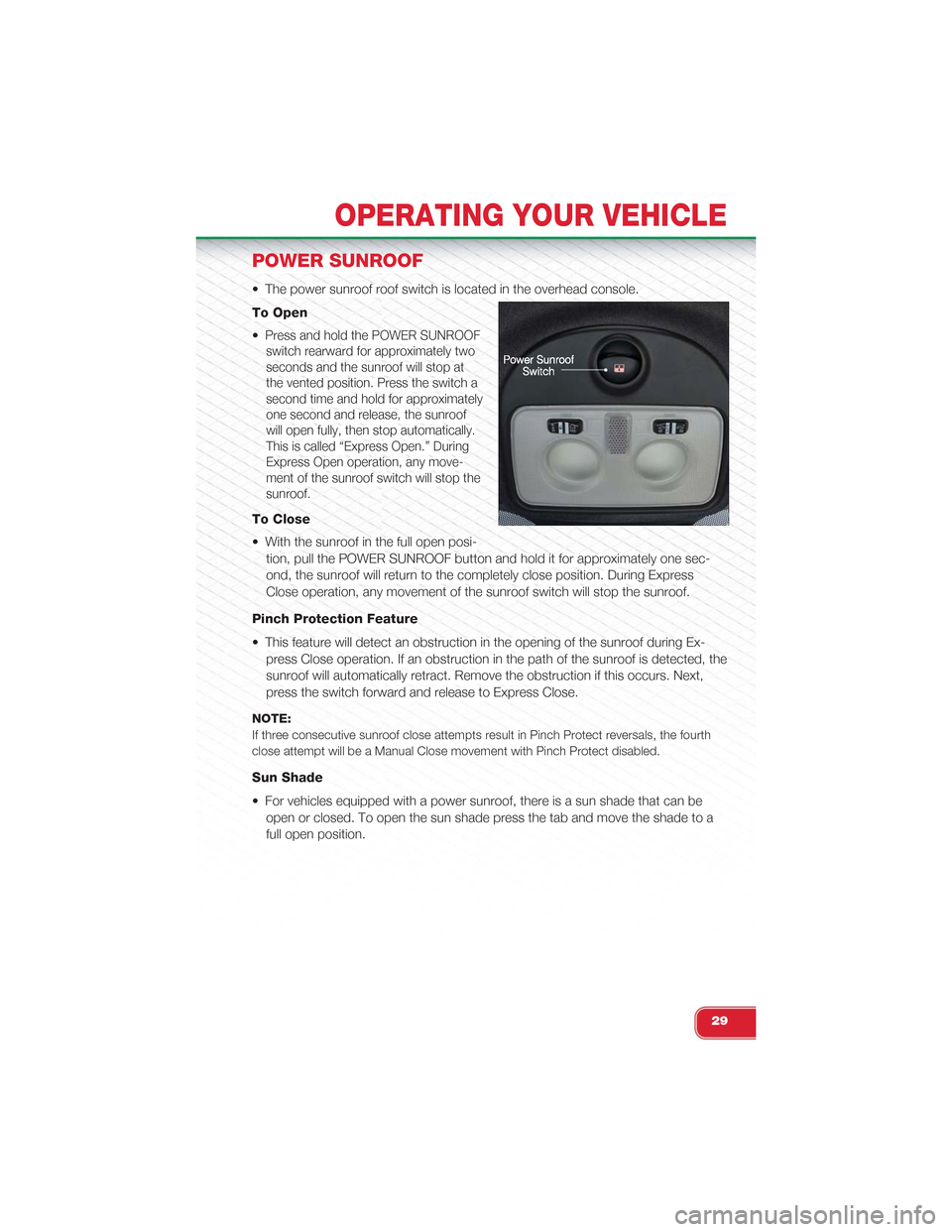
POWER SUNROOF
• The power sunroof roof switch is located in the overhead console.
To Open
•Press and hold the POWER SUNROOF
switch rearward for approximately two
seconds and the sunroof will stop at
the vented position. Press the switch a
second time and hold for approximately
one second and release, the sunroof
will open fully, then stop automatically.
This is called “Express Open.” During
Express Open operation, any move-
ment of the sunroof switch will stop the
sunroof.
To Close
• With the sunroof in the full open posi-
tion, pull the POWER SUNROOF button and hold it for approximately one sec-
ond, the sunroof will return to the completely close position. During Express
Close operation, any movement of the sunroof switch will stop the sunroof.
Pinch Protection Feature
• This feature will detect an obstruction in the opening of the sunroof during Ex-
press Close operation. If an obstruction in the path of the sunroof is detected, the
sunroof will automatically retract. Remove the obstruction if this occurs. Next,
press the switch forward and release to Express Close.
NOTE:
If three consecutive sunroof close attempts result in Pinch Protect reversals, the fourth
close attempt will be a Manual Close movement with Pinch Protect disabled.
Sun Shade
• For vehicles equipped with a power sunroof, there is a sun shade that can be
open or closed. To open the sun shade press the tab and move the shade to a
full open position.
OPERATING YOUR VEHICLE
29
Page 32 of 88
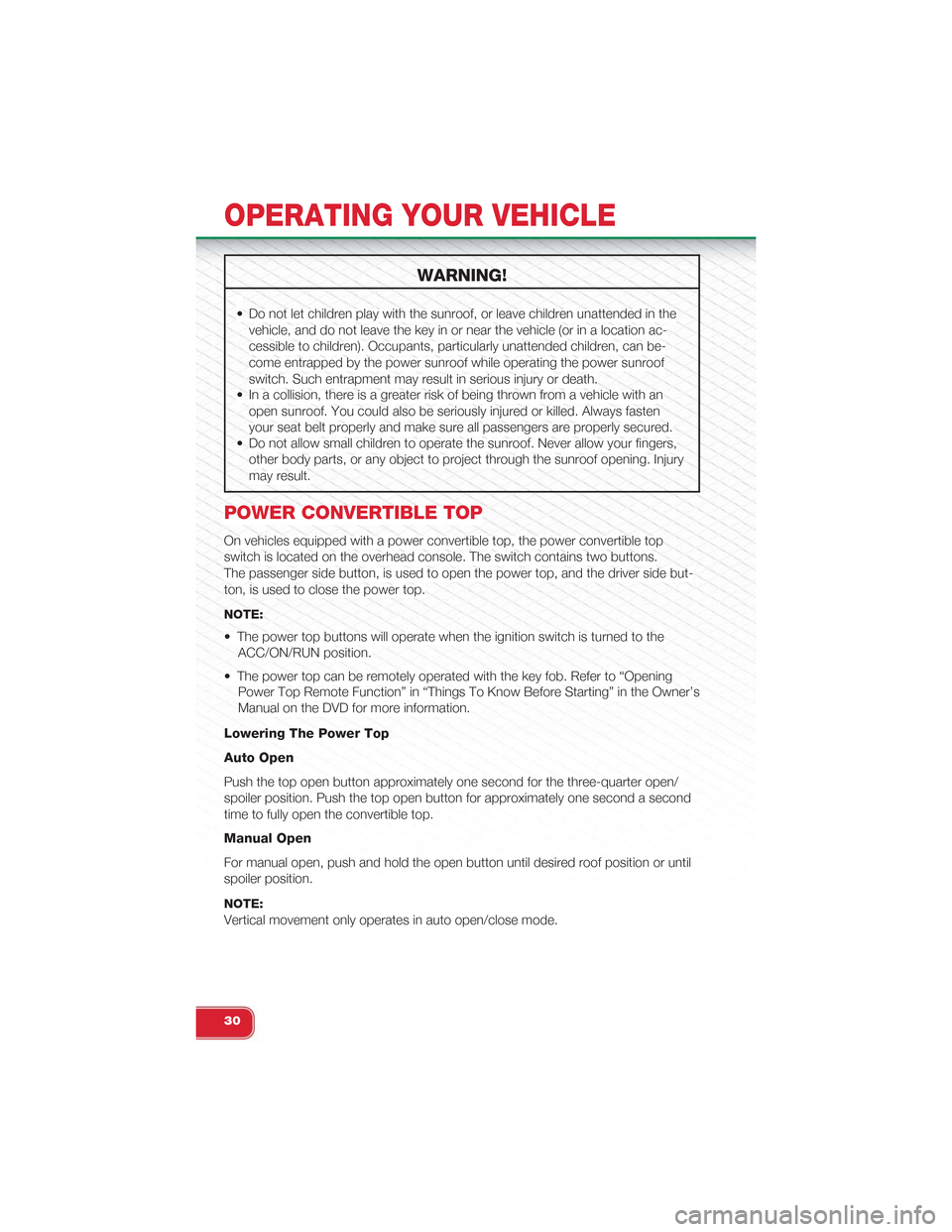
WARNING!
• Do not let children play with the sunroof, or leave children unattended in the
vehicle, and do not leave the key in or near the vehicle (or in a location ac-
cessible to children). Occupants, particularly unattended children, can be-
come entrapped by the power sunroof while operating the power sunroof
switch. Such entrapment may result in serious injury or death.
• In a collision, there is a greater risk of being thrown from a vehicle with an
open sunroof. You could also be seriously injured or killed. Always fasten
your seat belt properly and make sure all passengers are properly secured.
• Do not allow small children to operate the sunroof. Never allow your fingers,
other body parts, or any object to project through the sunroof opening. Injury
may result.
POWER CONVERTIBLE TOP
On vehicles equipped with a power convertible top, the power convertible top
switch is located on the overhead console. The switch contains two buttons.
The passenger side button, is used to open the power top, and the driver side but-
ton, is used to close the power top.
NOTE:
• The power top buttons will operate when the ignition switch is turned to the
ACC/ON/RUN position.
• The power top can be remotely operated with the key fob. Refer to “Opening
Power Top Remote Function” in “Things To Know Before Starting” in the Owner’s
Manual on the DVD for more information.
Lowering The Power Top
Auto Open
Push the top open button approximately one second for the three-quarter open/
spoiler position. Push the top open button for approximately one second a second
time to fully open the convertible top.
Manual Open
For manual open, push and hold the open button until desired roof position or until
spoiler position.
NOTE:
Vertical movement only operates in auto open/close mode.
OPERATING YOUR VEHICLE
30
Page 64 of 88
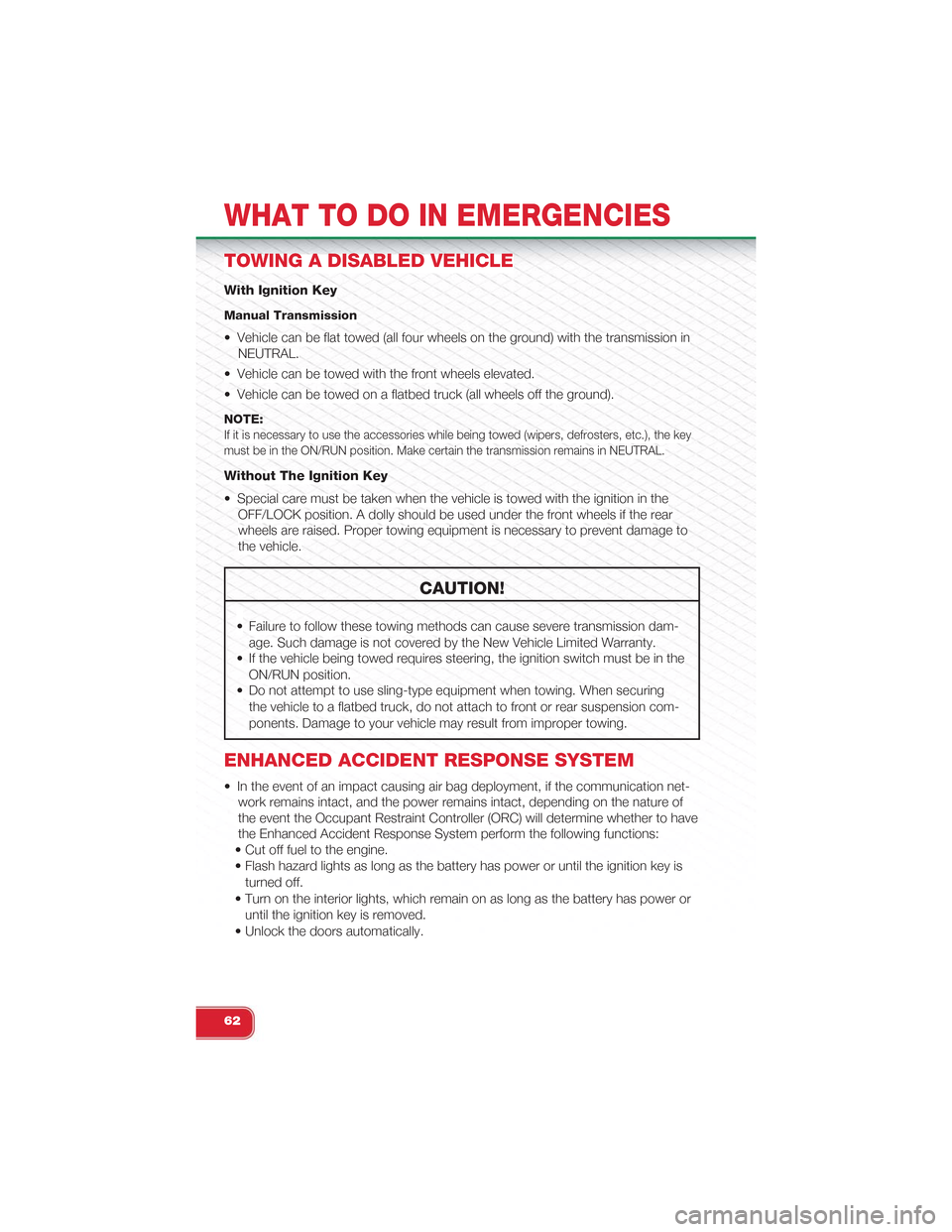
TOWING A DISABLED VEHICLE
With Ignition Key
Manual Transmission
• Vehicle can be flat towed (all four wheels on the ground) with the transmission in
NEUTRAL.
• Vehicle can be towed with the front wheels elevated.
• Vehicle can be towed on a flatbed truck (all wheels off the ground).
NOTE:If it is necessary to use the accessories while being towed (wipers, defrosters, etc.), the keymust be in the ON/RUN position. Make certain the transmission remains in NEUTRAL.
Without The Ignition Key
• Special care must be taken when the vehicle is towed with the ignition in the
OFF/LOCK position. A dolly should be used under the front wheels if the rear
wheels are raised. Proper towing equipment is necessary to prevent damage to
the vehicle.
CAUTION!
• Failure to follow these towing methods can cause severe transmission dam-
age. Such damage is not covered by the New Vehicle Limited Warranty.
• If the vehicle being towed requires steering, the ignition switch must be in the
ON/RUN position.
• Do not attempt to use sling-type equipment when towing. When securing
the vehicle to a flatbed truck, do not attach to front or rear suspension com-
ponents. Damage to your vehicle may result from improper towing.
ENHANCED ACCIDENT RESPONSE SYSTEM
• In the event of an impact causing air bag deployment, if the communication net-
work remains intact, and the power remains intact, depending on the nature of
the event the Occupant Restraint Controller (ORC) will determine whether to have
the Enhanced Accident Response System perform the following functions:
• Cut off fuel to the engine.
• Flash hazard lights as long as the battery has power or until the ignition key is
turned off.
• Turn on the interior lights, which remain on as long as the battery has power or
until the ignition key is removed.
• Unlock the doors automatically.
WHAT TO DO IN EMERGENCIES
62
Page 81 of 88
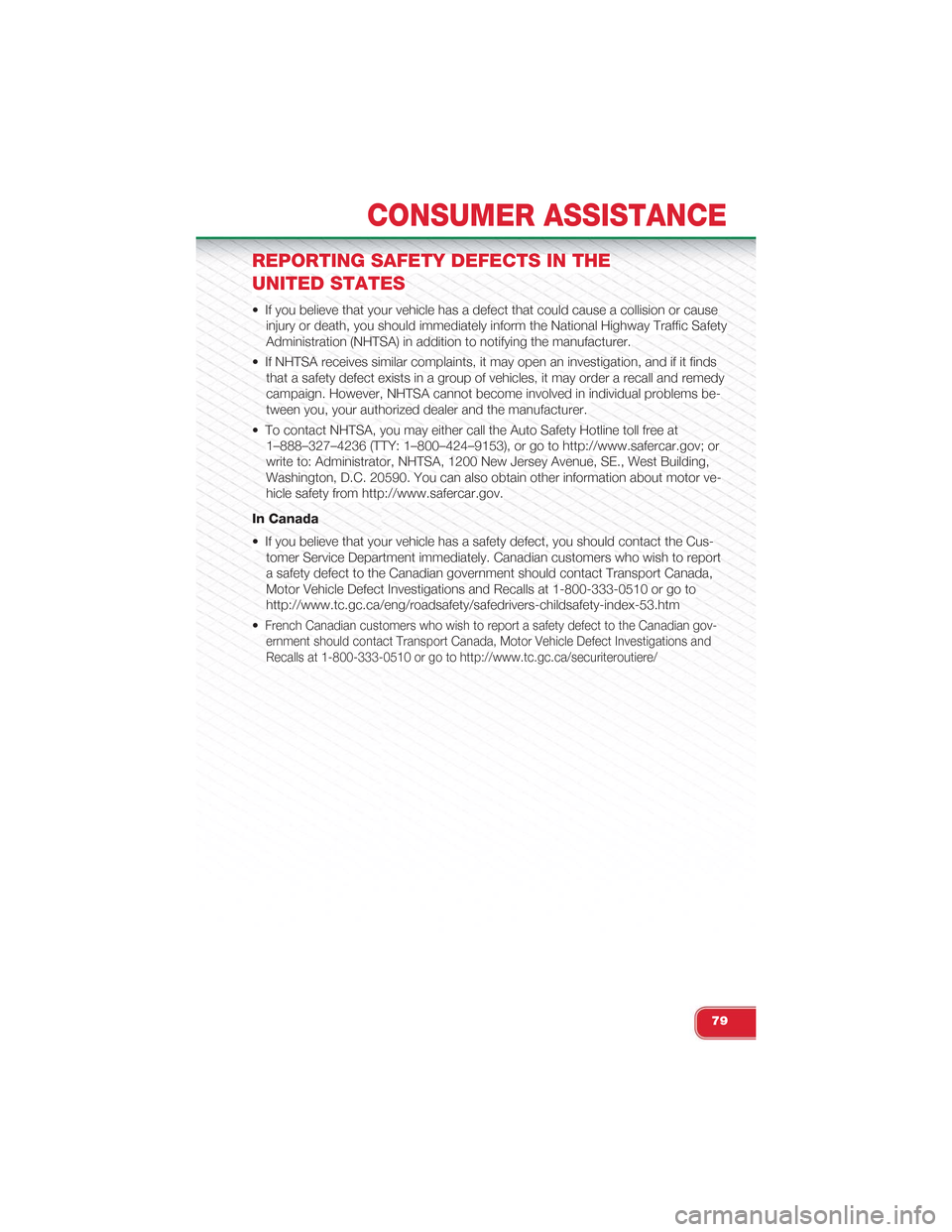
REPORTING SAFETY DEFECTS IN THE
UNITED STATES
• If you believe that your vehicle has a defect that could cause a collision or cause
injury or death, you should immediately inform the National Highway Traffic Safety
Administration (NHTSA) in addition to notifying the manufacturer.
• If NHTSA receives similar complaints, it may open an investigation, and if it finds
that a safety defect exists in a group of vehicles, it may order a recall and remedy
campaign. However, NHTSA cannot become involved in individual problems be-
tween you, your authorized dealer and the manufacturer.
• To contact NHTSA, you may either call the Auto Safety Hotline toll free at
1–888–327–4236 (TTY: 1–800–424–9153), or go to http://www.safercar.gov; or
write to: Administrator, NHTSA, 1200 New Jersey Avenue, SE., West Building,
Washington, D.C. 20590. You can also obtain other information about motor ve-
hicle safety from http://www.safercar.gov.
In Canada
• If you believe that your vehicle has a safety defect, you should contact the Cus-
tomer Service Department immediately. Canadian customers who wish to report
a safety defect to the Canadian government should contact Transport Canada,
Motor Vehicle Defect Investigations and Recalls at 1-800-333-0510 or go to
http://www.tc.gc.ca/eng/roadsafety/safedrivers-childsafety-index-53.htm
•French Canadian customers who wish to report a safety defect to the Canadian gov-
ernment should contact Transport Canada, Motor Vehicle Defect Investigations and
Recalls at 1-800-333-0510 or go to http://www.tc.gc.ca/securiteroutiere/
CONSUMER ASSISTANCE
79
Page 84 of 88
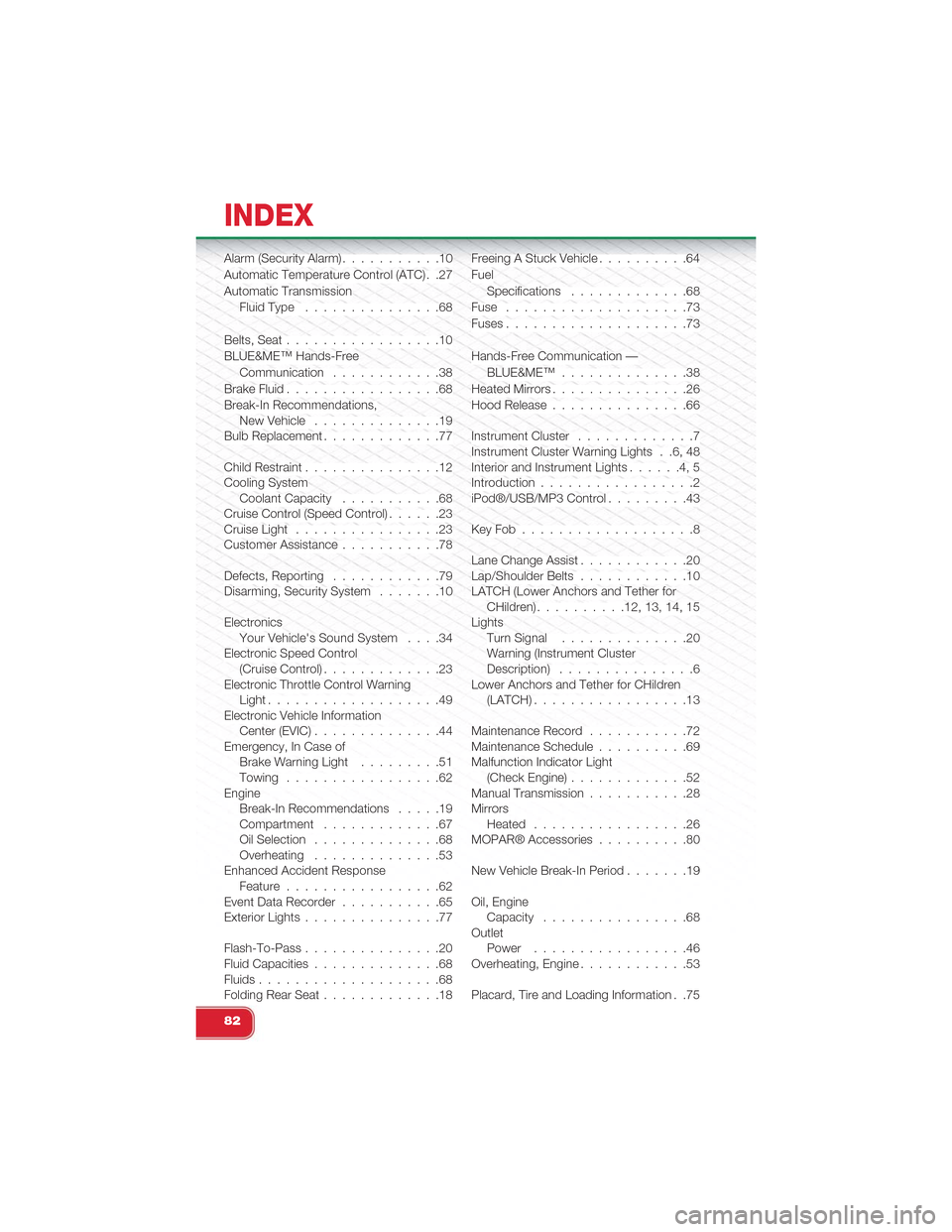
Alarm (Security Alarm). . . . . . . . . . .10
Automatic Temperature Control (ATC) . .27
Automatic Transmission
Fluid Type. . . . . . . . . . . . . . .68
Belts, Seat. . . . . . . . . . . . . . . . .10
BLUE&ME™ Hands-Free
Communication. . . . . . . . . . . .38
Brake Fluid. . . . . . . . . . . . . . . . .68
Break-In Recommendations,New Vehicle. . . . . . . . . . . . . .19Bulb Replacement. . . . . . . . . . . . .77
Child Restraint. . . . . . . . . . . . . . .12Cooling SystemCoolant Capacity. . . . . . . . . . .68Cruise Control (Speed Control). . . . . .23Cruise Light. . . . . . . . . . . . . . . .23Customer Assistance. . . . . . . . . . .78
Defects, Reporting. . . . . . . . . . . .79Disarming, Security System. . . . . . .10
ElectronicsYour Vehicle's Sound System. . . .34Electronic Speed Control(Cruise Control). . . . . . . . . . . . .23Electronic Throttle Control WarningLight. . . . . . . . . . . . . . . . . . .49Electronic Vehicle InformationCenter (EVIC). . . . . . . . . . . . . .44Emergency, In Case ofBrake Warning Light. . . . . . . . .51Towing. . . . . . . . . . . . . . . . .62EngineBreak-In Recommendations . . . . .19Compartment. . . . . . . . . . . . .67Oil Selection. . . . . . . . . . . . . .68Overheating. . . . . . . . . . . . . .53Enhanced Accident ResponseFeature. . . . . . . . . . . . . . . . .62Event Data Recorder. . . . . . . . . . .65Exterior Lights. . . . . . . . . . . . . . .77
Flash-To-Pass. . . . . . . . . . . . . . .20Fluid Capacities. . . . . . . . . . . . . .68Fluids. . . . . . . . . . . . . . . . . . . .68Folding Rear Seat. . . . . . . . . . . . .18
Freeing A Stuck Vehicle . . .. . . . . . .64
Fuel
Specifications . . . .. . . . . . . . .68
Fuse . . . .. . . . . . . . . . . . . . . .73
Fuses . . . .. . . . . . . . . . . . . . . .73
Hands-Free Communication —
BLUE&ME™. . . . . . . . . . . . . .38
Heated Mirrors . . . . .. . . . . . . . . .26
Hood Release . .. . . . . . . . . . . . .66
Instrument Cluster . .. . . . . . . . . . .7Instrument Cluster Warning Lights . .6, 48Interior and Instrument Lights. . . . . .4, 5Introduction. . . . . . . . . . . . . . . . .2iPod®/USB/MP3 Control .. . . . . . . .43
Key Fob . . . . . . . . . . . . . . . . . . .8
Lane Change Assist. . . . . . . . . . . .20Lap/Shoulder Belts. . . . . . . . . . . .10LATCH (Lower Anchors and Tether forCHildren)..........12, 13, 14, 15LightsTurn Signal . . . . .. . . . . . . . .20Warning (Instrument ClusterDescription) .. . . . . . . . . . . . . .6Lower Anchors and Tether for CHildren(LATCH). . . . . . . . . . . . . . . . .13
Maintenance Record .. . . . . . . . . .72Maintenance Schedule. . . . . . . . . .69Malfunction Indicator Light(Check Engine). . . . . . . . . . . . .52Manual Transmission. . . . . . . . . . .28MirrorsHeated . . .. . . . . . . . . . . . . .26MOPAR® Accessories. . . . . . . . . .80
New Vehicle Break-In Period. . . . . . .19
Oil, EngineCapacity. . . . . . . . . . . . . . . .68OutletPower. . . . . . . . . . . . . . . . .46Overheating, Engine . .. . . . . . . . . .53
Placard, Tire and Loading Information . .75
INDEX
82
Page 85 of 88
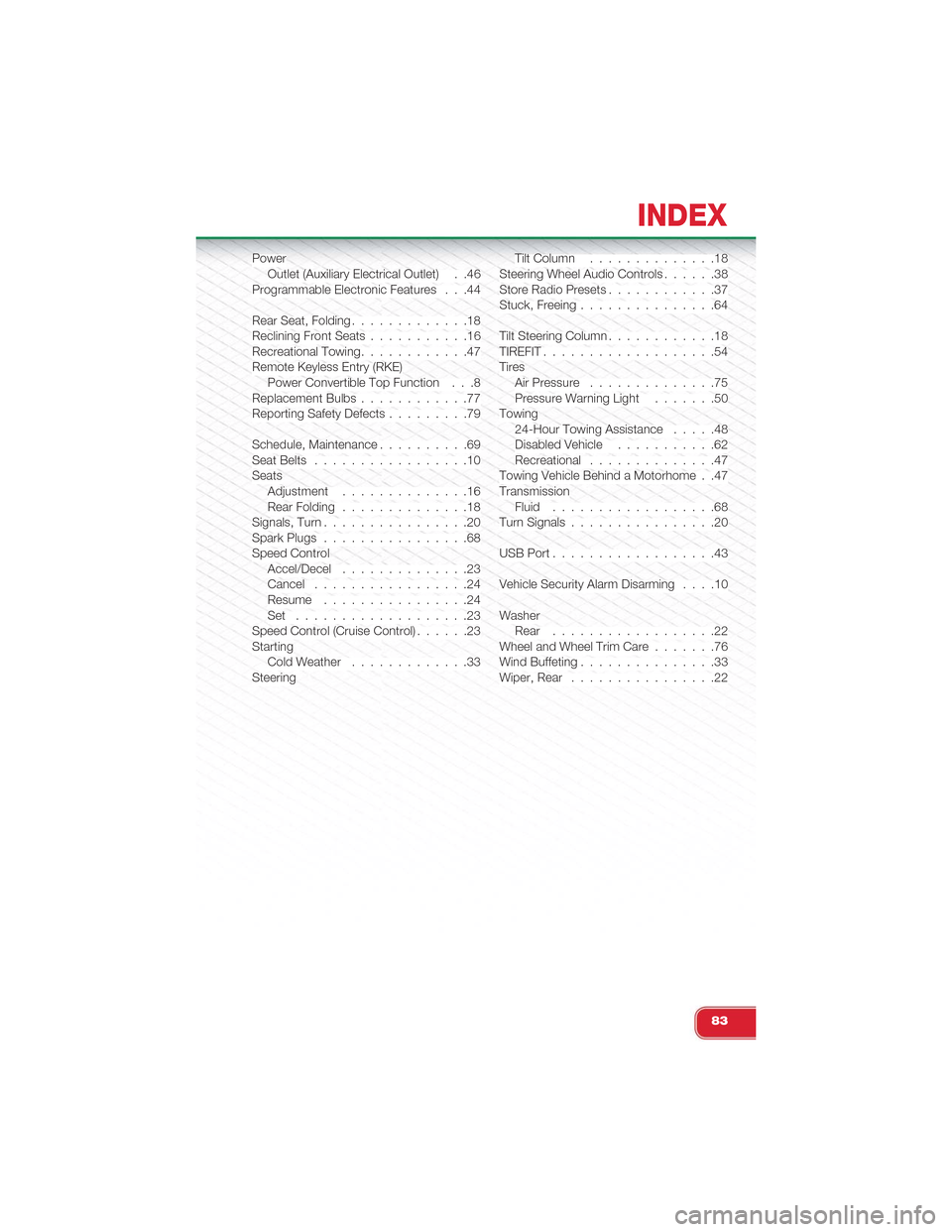
PowerOutlet (Auxiliary Electrical Outlet) . .46Programmable Electronic Features . . .44
Rear Seat, Folding. . . . . . . . . . . . .18Reclining Front Seats. . . . . . . . . . .16Recreational Towing. . . . . . . . . . . .47Remote Keyless Entry (RKE)Power Convertible Top Function . . .8Replacement Bulbs. . . . . . . . . . . .77Reporting Safety Defects. . . . . . . . .79
Schedule, Maintenance. . . . . . . . . .69Seat Belts. . . . . . . . . . . . . . . . .10SeatsAdjustment. . . . . . . . . . . . . .16Rear Folding. . . . . . . . . . . . . .18Signals, Turn. . . . . . . . . . . . . . . .20Spark Plugs. . . . . . . . . . . . . . . .68Speed ControlAccel/Decel. . . . . . . . . . . . . .23Cancel. . . . . . . . . . . . . . . . .24Resume. . . . . . . . . . . . . . . .24Set . . . . . . . . . . . . . . . . . . .23Speed Control (Cruise Control). . . . . .23StartingCold Weather. . . . . . . . . . . . .33Steering
Tilt Column .. . . . . . . . . . . . .18Steering Wheel Audio Controls .. . . . .38Store Radio Presets . .. . . . . . . . . .37Stuck, Freeing .. . . . . . . . . . . . . .64
Tilt Steering Column. . . . . . . . . . . .18TIREFIT . . .. . . . . . . . . . . . . . . .54TiresAir Pressure .. . . . . . . . . . . . .75Pressure Warning Light .. . . . . .50Towing24-Hour Towing Assistance .. . . .48Disabled Vehicle . . .. . . . . . . .62Recreational. . . . . . . . . . . . . .47Towing Vehicle Behind a Motorhome . .47TransmissionFluid. . . . . . . . . . . . . . . . . .68Turn Signals . .. . . . . . . . . . . . . .20
USB Port. . . . . . . . . . . . . . . . . .43
Vehicle Security Alarm Disarming . . . .10
WasherRear .. . . . . . . . . . . . . . . . .22Wheel and Wheel Trim Care. . . . . . .76Wind Buffeting. . . . . . . . . . . . . . .33Wiper, Rear . .. . . . . . . . . . . . . .22
INDEX
83